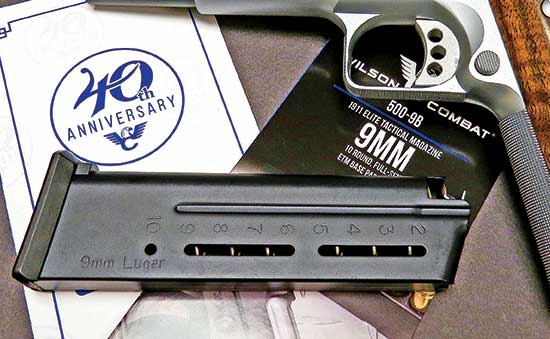The 9mm 1911
Fad, Trend Or Here To Stay?
It’s been easy for me to look at some trends in the world of handguns and decide which were just flashes in the pan, and which were going to last. Once or twice, I’ve even been right! Someone recently asked me about the 9mm 1911 “fad” and I found myself explaining the differences between a fad, a trend and a movement.
Those 9mm 1911’s have become increasingly popular recently, and for good reasons. Lower cost, lighter recoil and even lighter weight (9 rounds of .45 ACP is two full ounces heavier than 11 rounds of 9mm). Having had the chance to build a few for my customers, I’d also say they bring a new level of fun to shooters who may find it altogether easier to shoot than the same gun in .45.
As the popularity of the platform continues to grow, more manufacturers are offering 9mm 1911’s in a variety of configurations. Competition is fairly intense as the makers try to increase market share. We’ve all heard the saying “Racing improves the breed” and it’s true here too. Guns improve as the various quirks and problems of the 9mm 1911 are addressed.
Early Issues
For those of us not entirely content to just buy a new gun off the rack, this is a bonanza of new products and concepts allowing us to solve long-standing problems. The 9mm in 1911’s have always been a little less reliable than the .45’s. There’s less power to run the slide, magazines were never just right, ejection and extraction issues and lock-back inconsistency were common complaints.
I’ll admit I wasn’t convinced the developments of fixes for these problems would ever come about, and I watched with interest, but also a little skepticism. Chuck Warner of Warner Precision in New Mexico started experimenting with a single-lug barrel several years ago. I watched his work with my typical jaded perspective, thinking it would never catch on in the mainstream. As of now though, his barrels have won one international and several US championship titles. This concept is going to catch on — it offers less drag and resistance on unlocking, something the 9mm guns can surely benefit from.
As you’d expect, one of the companies at the forefront of design and development for the better 9mm 1911 is Wilson Combat. Bill Wilson saw the coming surge, and got in front of it by developing solutions to the common problems plaguing the gun for decades. I’ve talked at length with Anthony Lombardo from Wilson’s regarding some of the improvements they’ve made. The new improved ETM magazine incorporates many subtle, but new features like a steel follower for durability and reliable lock-back, and modifications to ensure the feeding of all bullet styles. Complementing this new magazine is a new slide stop, #414BS, optimized to clear all bullet noses, and still securely contact the magazine follower.
Reliable Extraction?
It seems 9mm 1911’s have always had a hard time “taking out the trash” too. Many factors come into play here, from mainspring rate, to ejector length, extractor fit and tension, recoil spring rate, and internal friction. It appears Wilson’s has dissected the problem, and provided solutions. Most 9mm’s come with a really long ejector, presumably to ensure early contact with a fired case while the slide still has sufficient rearward velocity to kick it out. I’ve always favored a slightly shorter ejector and a lighter recoil spring to accomplish the same thing.
Wilson’s new #34P ejector is made this way, and it works perfectly. Their new Bullet Proof extractor, #415-S70 is completely redesigned, from the shape and position of the hook to the very material it’s made from. Fully machined from S-7 tool steel, this extractor is made to hold up to high-round count shooting much better than a typical factory-spec part.
Possibly the most important aspect of getting the 9mm 1911 to cycle well is the recoil spring setup. I’ve had spring rates differ on guns identical in every other respect. It’s been frustrating sometimes to get a gun to run with different loads and the same spring. Wilson’s flat-wire spring kit is, in my view, the single largest improvement you can make to the performance of an otherwise correctly set-up 9mm 1911. The flat wire spring offers compression and return rates more consistent throughout the cycle, coupled with an impressive increase in durability over round-wire springs.
There’s nothing static about needing to answer the “What’s new?” question each year at the SHOT Show — and the improvements to the 9mm 1911 are proof.






